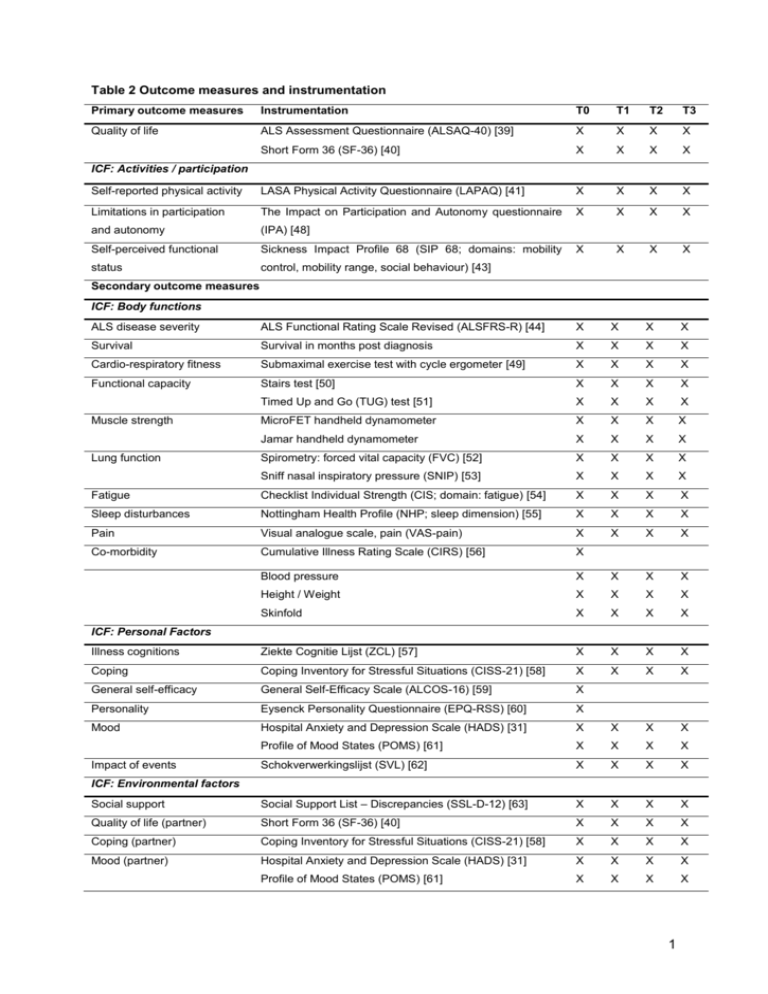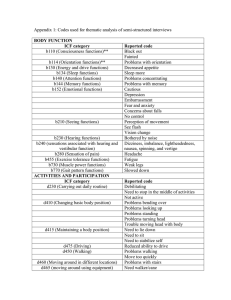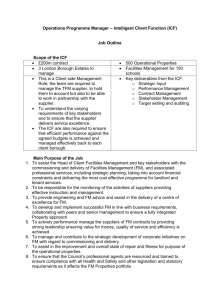Table 2 Outcome measures and instrumentation
advertisement

Table 2 Outcome measures and instrumentation Primary outcome measures Instrumentation T0 T1 T2 T3 Quality of life ALS Assessment Questionnaire (ALSAQ-40) [39] X X X X Short Form 36 (SF-36) [40] X X X X Self-reported physical activity LASA Physical Activity Questionnaire (LAPAQ) [41] X X X X Limitations in participation The Impact on Participation and Autonomy questionnaire X X X X and autonomy (IPA) [48] Self-perceived functional Sickness Impact Profile 68 (SIP 68; domains: mobility X X X X status control, mobility range, social behaviour) [43] ICF: Activities / participation Secondary outcome measures ICF: Body functions ALS disease severity ALS Functional Rating Scale Revised (ALSFRS-R) [44] X X X X Survival Survival in months post diagnosis X X X X Cardio-respiratory fitness Submaximal exercise test with cycle ergometer [49] X X X X Functional capacity Stairs test [50] X X X X Timed Up and Go (TUG) test [51] X X X X MicroFET handheld dynamometer X X X X Jamar handheld dynamometer X X X X Spirometry: forced vital capacity (FVC) [52] X X X X Sniff nasal inspiratory pressure (SNIP) [53] X X X X Fatigue Checklist Individual Strength (CIS; domain: fatigue) [54] X X X X Sleep disturbances Nottingham Health Profile (NHP; sleep dimension) [55] X X X X Pain Visual analogue scale, pain (VAS-pain) X X X X Co-morbidity Cumulative Illness Rating Scale (CIRS) [56] X Blood pressure X X X X Height / Weight X X X X Skinfold X X X X Illness cognitions Ziekte Cognitie Lijst (ZCL) [57] X X X X Coping Coping Inventory for Stressful Situations (CISS-21) [58] X X X X General self-efficacy General Self-Efficacy Scale (ALCOS-16) [59] X Personality Eysenck Personality Questionnaire (EPQ-RSS) [60] X Mood Hospital Anxiety and Depression Scale (HADS) [31] X X X X Profile of Mood States (POMS) [61] X X X X Schokverwerkingslijst (SVL) [62] X X X X Social support Social Support List – Discrepancies (SSL-D-12) [63] X X X X Quality of life (partner) Short Form 36 (SF-36) [40] X X X X Coping (partner) Coping Inventory for Stressful Situations (CISS-21) [58] X X X X Mood (partner) Hospital Anxiety and Depression Scale (HADS) [31] X X X X Profile of Mood States (POMS) [61] X X X X Muscle strength Lung function ICF: Personal Factors Impact of events ICF: Environmental factors 1 Caregiver strain (partner) Caregiver Strain Index (CSI) [45] X X X X Other factors T0 T1 T2 T3 Demographic variables (age, gender, ethnicity, marital status, children, education, work, X religion, participation in other study) of patient and partner T1; pre-treatment, T2; post-treatment, T3; short-term follow-up, T4; long-term follow-up. 2 3











